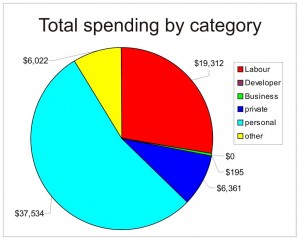The School Board Trustee election is sometimes the most “local” of all local elections. The 2011 edition in New West comes on the heels of some pretty ugly politicking around the previous board. A vocal DPAC has accused the Board of everything short of fraud, and seems to see Conflict of Interest luring behind every corner (a battle that seems to be ongoing).
I don’t have any kids, and don’t plan to, so my interest in the School Board is completely from the taxpayer side. I pay school taxes every year, and don’t really begrudge it: a well-educated populace benefits society, so paying my part for the education of other people’s kids doesn’t really offend me too much, much like I don’t mind my taxes going to a hospital that I have never needed the services of…
However, after attending a Board Meeting last year to talk on what I thought was a well-intentioned student-led project, I watched the silly partisan bickering taking place, and walked out embarrassed for the entire adult population of the School system (The students in attendance were the models of reason and decorum: stunning in contrast). So I went into this election with a bit of a “pox on both their houses” mentality, and decided to support a couple of new candidates who seemed to have their heads screwed on right. They both finished well atop the popular vote, but I suspect it had less to do with my support than the support of the District Labour Council. I’m just not sure the financial support from Labour is really that meaningful.
 |
| Click to make bigger |
Look at the money raised by the candidates (order from left to right by the number of votes, Mortenson crossed the elected threshold, Goring did not):
Of course, the outstanding numbers here are the money provided by “Labour” to four of the candidates, all elected. At and average of $4,800 per candidate, this clearly puts those four candidate way above the rest of the field in spending. Actually, without the money from Labour, they would have still been the top four spenders in the election by a healthy margin. So the utility of having all that extra cash is suspect. Especially if you plot the number of votes vs. the amount of spending:
Note those 4 circled outliers: that is the strange result of the labour funding.
There are other trends to take note of. Jonina Campbell was the most effective fundraiser (even discounting the Labour money) by far. I suspect that had much to do with her rather refreshing approach and her very effective public speaking during the campaign. The amount of personal money that most candidates sunk into the election was also significant. Spending by the candidates themselves totalled almost $40,000 and almost twice as much as Organized Labour spent on the School Board campaign in New Westminster.
Finally, a bi-modal distribution shows up again when you plot the amount of money spent by candidates per vote.
The Labour Council-backed candidates all spent a little more than $2 per vote, where the non-affiliated candidates all spent less than $1. More remarkable is that, outside of the vetted 4, there is little correlation between spending and the vote received. In the non-labour affiliated subgroup, the value of the candidate seems more important than the money spent.


